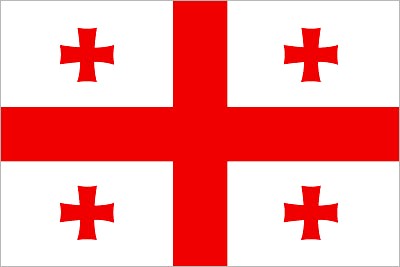-
- Georgia Map
|
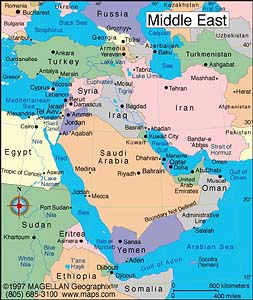  -
- Mid-East Map
Caucasus Map
-
|
|
-
|
- latest picture: June 13, 2013
|
|
-
-
-
-

|
-
-

|
-
-
-
-

|
- 001
June 4th, 2013: From the border town
- of Sarpi south of Batumi we look back to
- Turkey where at the Black Sea a lonely
- mosque “keeps watch”. Georgia practices
- predominantly the Georgian Orthodox Church
|
- 002
The former building of the National
- Bank of Georgia at the Europe Square in
- the center of Batumi has now an
- astronomical clock on its tower –
- like in Prague and Venice
|
- 003
Futuristic buildings line the Seaside
- Boulevard in Batumi, Georgia`s main
- summer holiday town: Left to right: Hotel
- Radisson-Blu; Batumi Tower Business
- Center; Grand-Hotel Kempinski
|
-
- We are completely euphoric – we are breaking new ground:
Georgia, our 173rd country. In the clear morning of June 4th, 2013,
arriving from Turkey, we reach the
borderpost of Sarpi near Batumi. The first surprise: There is no
queue. The second: Customs, the first check point, waves us through
to the immigration. The third: Merely due to our full passports we
get stuck for a couple of minutes because the two ladies in the
booth try to find a free space for their entry stamp. (The new
passports are ready for us at our consulate in the capital Tbilisi).
The forth: We do not have to buy an insurance for €25, mentioned by
a friend. The fifth: The first travelers we meet are Swiss – three
motorbikers on a four weeks tour through Georgia.
|
-
-

|
-
-

|
-
-

|
- 004
The pebble beach of Batumi is
- stretching 5 miles along the coast –
- from the port to the airport
|
- 005
The Miracle Park of Batumi. Batumi
- with a population of about 200’000 is the
- capital of the province of Ajaria
|
- 006
On the way from Batumi to the
- Goderdzi Pass is the confluence of the
- Chorokhi and Adzhari Rivers. The former
- originates in Turkey (Çoruh River – picture
- #80), i.e. from the huge dam near Artvin
|
-
- Batumi has about 200‘000 people and is the capital of the
autonomous province of Adjaria. We like it straightaway. It is a
pleasant city with futuristic new buildings, a four mile long
seaside promenade with cafes, gardens, parks and monuments. But also
with an attractive center like most of the East European cities we
know. On the western side the Black Sea is sparkling, on the eastern
side lush green hills are greeting. Today, however, they are hidden
in dense mist. Batumi is Georgia’s main summer holiday resort with
hotels springing up like mushrooms.
|
-
-

|
-
-

|
-
-

|
- 007
The Zvare Church northeast of the
- village of Keda on the Batumi-Akhaltsikhe
- “Highway” is active since 2003 and famous
- for wedding ceremonies
|
- 008
"Yes, we are free from giddiness! (or
- yet not that much)". The thin bridge arch of
- the historic Dandalo Bridge on the Batumi-
- Akhaltsikhe “Highway“ is 28 ft. above
- water level. It is built of natural rock stones
|
- 009
The church of Khulo (Annunciation
- Church?) is situated about 50 miles east
- of Batumi along the bad main road to
- Akhaltsikhe (Batumi-Khulo paved, after-
- wards for 30 miles “nearly 4x4” condition)
|
-
- At the first supermarket we browse around the well stocked
shelves and compare prices. It is a positive surprise: Our shopping
cart soon fills with cheese, dark bread, cooked ham and a 3 litre
bottle of red wine, all for around US$6. With all these goodies we
head to the nearby pebble beach and toast with one/two glasses of
wine to our new country. The ham and cheese together with hashbrowns
and salad becomes our first lunch in our new country Georgia, and
the huge truck stop near the border our first night spot. There are
even cheap hot showers.
|
-
-
-
-

|
-
-

|
-
-
-
-

|
- 010
Often there are special views across
- the Adzhari River. The Batumi-Akhaltsikhe
- “Highway” often follows the riverbed, here
- on the northern side between Zvare and
- Tskhmorisi
|
- 011
There are not only stone bridges
- but also suspension bridges that lead to
- the south side of the Adzhari River. Here
- between Khichauri and Shuakhevi
|
- 012
The Kaviani Fortress near Khichauri
- is easily overlooked among the dense forest.
- It is built of natural and cobble stones. The
- walls are more than three feet thick
|
-
- A pack of barking dogs at the big truck stop interrupt our night
sleep. After 8am we are ready to hit the road again. We refuel, buy
bread and Vienna sausages and turn eastwards towards the
Batumi-Akhaltsikhe-„Highway“. Our destination is the Goderdzi Pass
that runs along the Turkish border. The road first follows the
narrow valley of the Adzhari River and continues along a romantic
deeply forested area with old natural stone and suspension bridges.
Especially eyecatching are also the cute Svare Church northeast of
Keda and the ruins of the Kaviani Fortress near Khichauri built from
natural and cobble stones towering from the dense forest.
|
-
-

|
-
-

|
-
-

|
- 013
On our climb to the 6’644 ft. high
- Goderdzi Pass we enjoy the view of
- this wild blooming hydrangea
|
- 014
Farmers on the bridge of their pick-
- up have no choice than swallowing dust.
- The asphalt road towards the Goderdzi Pass
- ends in Khulo. Then 4x4 is an advantage
|
- 015
Such a shiny Marsh Marigold
- (Caltha palustris) "bouquet"
- is always a motif for a picture. Here
- on the road to the Goderdzi Pass
|
-
- According to Lonely Planet guidebook, the mountain road is
paved. Yes it is, but only as far as Khulo from where 4x4 is
essential for us for the next 31 miles [50km]. At one point, a
critical passage gets our adrenalin pretty much flowing. It is so
precarious that our LandCruiser is on the brink to tip over. It is
not the first time that we curse Lonely Planet for nowadays often
not being reliable anymore, but today especially it strains every
nerve as during 8½ hours continuous driving we merely manage to
accomplish 93ms [150km].
|
-
-

|
-
-

|
-
-
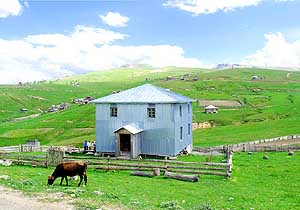
|
- 016
The partly dilapidated looking
- clapboard houses in the hamlet of Goderdzi
- are still inhabited – even in winter
|
- 017
We made it to the Goderdzi Pass on
- an altitude of 6’644 ft. But the 4x4 part gave
- us a hard time. Once we were on the brink to
- tip over due to a precarious sloping condition
|
- 018
Does this house built entirely
- of corrugated iron eventually mark a
- new construction method in this
- mountain region?
|
-
- The landscape of the western ascent to
the 6‘644 ft. [2'025m] high pass has a touch of Switzerland: Alpine
pasture with grazing cows, wooden „chalets“ and forests dominate the
scenery. Looking closer at some of the wooden houses we have the
impression that they could collapse anytime like a house of cards.
But people still live there. Wood is chopped, milk cans are rinsed,
fence posts tapered and gardens tended. Close-by a granny bent down
by age is knitting while herding some cows. Rural life seems still
to be like in the old days.
|
-
-

|
-
-

|
-
-

|
- 019
A corner shop in the village of
- Goderdzi, obviously also a men's
- gathering place
|
- 020
Is this just a "summer residence"
- on the Goderdzi Pass? Looking at it
- closer we cannot imagine that this
- wooden house is suitable for winter
- time on an altitude of over 9’000 ft.
|
- 021
Milk cans are rinsed, fence posts
- tapered – rural life on Goderdzi Pass
- is still like in the old days
|
-
- When we finally reach the summit at 6'644ft. [2'025m], we relax
with two glasses of well deserved wine. Our lunch is simple and
fast: Hot Vienna sausages and bread. Then we start our eastern
descent. Striking is that the sprawled settlements that dot the
western side now stop all at once. The pine forest gets impenetrable
and is often interrupted by huge meadows of white daisies. Lila
hydrangeas, same-colored primroses and golden marsh marigolds
compete in glowing.
|
-
-
-
-

|
-
-

|
-
-
-
-

|
- 022
We are starting the descent to the
- east of Goderdzi Pass towards Akhaltsikhe.
- Interestingly the scattered villages of the
- western side stop abruptly, pine forests
- become denser .....
|
- 023
..... and flowers enjoy us more
- often like here the lovely primroses
- (Primula) on the roadside .....
|
- 024
..... or this beautiful meadow
- with flowering white daisies
- (Leucanthemum)
|
-
- It is a beautiful lonely drive on a road that is somewhat in a
better shape than the one on the western side of the Goderdzi Pass.
Darkness is approaching. We cannot yet judge the safety situation
for rough camping. An appropriate gasoline station is not in sight.
Therefore we decide to press on to the town of Akhaltsikhe where the
road splits: Either to Turkey, to
Armenia or to the
Georgian capital Tbilisi. We are
lucky to find a room with a living corner, wifi and breakfast for 50
Lari (= GEL) (US$31). We are both completely exhausted from the long
tiring journey. I wash a few things, Emil updates the change of
country on his statistics and at 10:30pm we are already deep asleep.
|
-
-
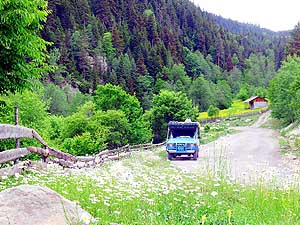
|
-
-

|
-
-

|
- 025
We roll lonely through forests
- and blooming meadows on the east side
- of the Goderdzi Pass, which is in a
- somewhat better shape
|
- 026
About 12 miles from the
- Goderdzi Pass sits the imposing
- Zarzma Monastery on a hill
|
- 027
The village of Skhvilisi, located
- about 3 miles west of Akhaltsikhe on
- the road to the Turkish border of Posof
|
-
- Breakfast is served only at 10am, far too late for us early
birds. We prepare our own and decide spontaneously to add a
travel-free day. The eye-catch of Akhaltsikhe is the imposing
fortress Rabati sitting on a hill on the outskirts of town. What
might be hiding behind the high walls and round watch towers? While
Emil is on the lookout for the telecom Magti to get a Sim card, I
buy an entry ticket for 5 Lari to the fortress.
|
-
-

|
-
-

|
-
-

|
- 028
The eye-catch of the town
- of Akhaltsikhe, what in Georgian means
- "New Castle", is the huge fortress lying
- on a hill and dating from the 12th century
|
- 029
Behind the high walls of the fortress
- with its many watchtowers beautiful
- jewels of buildings are hiding
|
- 030
The view from the Rabati castle
- extends to all directions as far as
- to the mountains
|
-
- From the very moment I step through the castle gate, my
enthusiasm never ceases. The fortress dating from the 12th century
is not a „normal“ living castle but a collection of magnificent
buildings set between beautiful flowering gardens: There is a mosque
with a golden dome, a white colonnaded temple, a church, a graceful
pavilion and a gushing fountain. To top it all, there is a glorious
panoramic view up to the mountains.
|
-
-

|
-
-

|
-
-

|
- 031
Inside the castle is a colonnaded
- temple, a church and a mosque, a graceful
- pavilion with a gushing fountain – everything
- is surrounded by beautiful gardens
|
- 032
The dark thunderstorm clouds leave
- the graceful pavilion in a magic light
|
- 033
Apocalyptic mood over the
- Akhaltsikhe Castle. The golden
- dome belongs to the mosque
|
-
- A thunderstorm is on the move. The skies darken at a tremendous
speed. They spread a kind of apocalyptic mood putting the buildings
still caught by sunrays into a magic light. And then the first heavy
raindrops fall. I hasten to the exit where Emil is already waiting
for me with the LandCruiser. As soon as I jumb inside it's raining
like hell. We battle our way to the city center to the Paemani
Restaurant specialized in „Khatchapuri“ (a cheese pie) – Georgia’s
speciality No. 1. Emil beams when his favorite dish is served. He
could easily live on cheese! Until we shall leave Georgia, he
probably will put on again his recently kilos he lost in Arabia and
Iran due to their alcohol
restrictions! But who wants to kill his joy!
|
-
-
-
-

|
-
-

|
-
-
-
-

|
- 034
The cathedral in the city center
- of Akhaltsikhe is surrounded with
- green patches and benches
|
- 035
Home-made tagliatelle in Akhaltsikhe
- – not entirely made by hand like Liliana`s
- mother still used to do it
|
- 036
The bread fresh from the clay
- oven tastes lovely and costs
- only $ 0.37/piece
|
-
- It is 10am when next day we drive out of the gate of the Mirage
Hotel and head towards the south to the famos Cave City of Vardzia.
The road snakes its way scenically along the idly flowing Mtkvari
River, through narrow gorges and a green valley framed by deeply
forested hills and towering bare rocks. At the Khertvisi Fortress,
sitting high up a hill, we branch off to Vardzia; the main road
leads towards Armenia. After 17km on
a good tarmac road we are at our destination. Seeing all the cars
and minibusses crammed together at the car park and the crowd
climbing up the steep path to the caves, curbs our thrill of
anticipation.
|
-
-

|
-
-

|
-
-

|
- 037
The road from Akhaltsikhe to the
- cave monastery of Vardzia follows the
- scenic course of the upper Mtkvari river.
- The landscape is very green, very
- beautiful and very diverse
|
- 038
25 miles from Akhaltsikhe and
- at the junction towards the cave city
- of Vardzia stands the Khertvisi Fortress
- from the 2nd century BC. The
- present walls were built 1354
|
- 039
Another beautiful flower carpet
- along the Mtkvari Rive lifts our spirit
|
-
- The current archaeological site of Vardzia was built as a
fortress by King Giorgi III in the 12th century. The dwellings
carved into the rock were allocated on 13 floors and included 407
rooms, 12 churches and 25 wine cellars! Under the reign of his
daughter, Queen Tamar, the cave city developped more and more to a
spiritual center. Testimony of that time is still the Church of the
Assumption with its fine frescoes dating between 1184 and 1186. And
the circular stairs and dark tunnels we take on our way back give us
also a brief insight into the history of Vardzia.
|
-
-

|
-
-
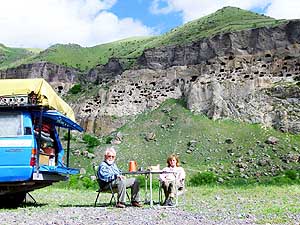
|
-
-

|
- 040
The current archaeological site of
- Vardzia was built as a fortress by King
- Giorgi III in the 12th century. Under the
- reign of his daughter, Queen Tamar, it
- developed more and more to a
- spiritual center .....
|
- 041
..... cave dwellings were carved
- from the rock, ranging over 13 floors.
- There were 409 rooms, 13 churches
- and 25 wine cellars .....
|
- 042
..... today only one church is left,
- the “Church of the Assumption“ with
- lovely frescoes painted between 1184
- and 1186. Here we shot a
- remembrance picture
|
-
- Who do we often encounter at remotest places: Swiss! At the
working nunnery one mile [2km] west of Vardzia with its church from
the 11th century a motorbike with Swiss license plates is parked. It
belongs to Otto. He was already in
Armenia and confirms what we already know: The roads there are
in miserable shape, but he experienced people friendlier and more
welcoming than here in Georgia. While the three of us are still in a
busy conversatin, the nun who showed us around the church brings us
a freshly baked round bread – a kind of flatbread. It is still warm
and crusty and we eat it on the spot to the last crumb. To park and
sleep in the car however, is not allowed here. But on the nearby
cave carpark which in the meantime is empty, we are welcome. A man
collects 5 Lari. It becomes one of our very bad nights.
|
-
-
-
-

|
-
-

|
-
-
-
-

|
- Vardzia is again a working monastery. Some cubicles are again inhabited by monks.
- Circular stairs and dark tunnels lead through the “cave city”
|
- 043
|
- 044
|
- 045
|
-
- A dog is barking incessantly, once right in front of our car,
once a bit further away to restart below the car. At 1:30am Emil
blows a fuse. He wants to pack up and drive away. Whereto in the
middle of the night? No way I will agree! Thus we endure the noise
totally browned off hour after hour until daybreak. When the
cleaning team arrives, an old man and an equally old woman, we are
ready to leave. For breakfast we move to the viewing site of the
cave city. When the morning sun is beautifully flooding it, we take
it as a well-earned reward for the past sleepless night.
|
-
-
-
-

|
-
-

|
-
-
-
-

|
- 046
Beetles feast on a white daisy
|
- 047
A Great Spotted Woodpecker
- (Dendrocopos major) makes a break
- and scans the environment
|
- 048
"Is there some food?" A seagull
- appears at our breakfast spot opposite
- the Vardzia cave monastery
|
-
- We are heading the same way back until Akhaltsikhe and then
continue towards Gori and Tbilisi. Until the turnoff in Khashuri,
where the main road from the Black Sea is met, the landscape is
still hilly and pretty. However from there it becomes monotonous.
Nothing but gasoline stations along the highway, only now and then a
field of flowers. The only attraction we find on our way to Gori is
the St. George’s church in Samtsevrisi from the 7th century, but
which door unfortunately is closed. Special is its adjacent
cemetery. Each tombstone is framed by a decorative metallic fence,
and the tombstones bear the pictures of the deceased. Mid-afternoon
we reach Gori, the birthplace of Stalin. We urgenly need some sleep
and are looking for a guesthouse. The only accomodation we find is
the Hotel Georgia, where all the rooms are facing the busy road.
Accordingly the night is again little relaxing.
|
-
-

|
-
-
-
-

|
-
-

|
- 049
The church belonging to a
- working nunnery 1½ miles west of
- Vardzia has some nice carvings. There
- are fruit orchards and a trout farm
|
- 050
Near the Vardzia cave monastery,
- the Mtkvari river snakes its way through
- a narrow canyon .....
|
- 051
..... the good road snakes its way
- also through the valley. Roads in Georgia
- that lead to tourist attractions are
- generally well constructed
|
-
- Who do we spot in front of the Tourist Information opposite the
Stalin Museum? An overlander bus on its way to Beijing. Its group of
18 guests is just visiting the museum and Pete, the nice driver and
his local guide have time to chat with us. They are a true source of
information about Azerbaijan and
Georgia. Being already in front of the Stalin Museum and this being
somehow special, we later also wander through the different rooms
for 10 Lari (about US$6) per person. The exhibition consists mainly
of photos, news paper clips, documents and historic moments. With a
very few exceptions, everything is labelled in Russian so that we
can take little advantage of it. The supervisor does not protest
when we take a picture of Stalin’s first office in the Kremlin and
the shot showing him together with Winston Churchil and Franklin D.
Roosevelt during the Yalta Conference early February 1945 in the
Crimea.
|
-
-

|
-
-

|
-
-

|
- 052
View to the monastery/castle complex
- of Samtsevrisi and down to the Mtkvari
- valley, in the background the village of
- Agara – about 20 miles west of Gori
|
- 053
The St. George's church in
- Samtsevrisi dates from the 7th century
- and sits high on a hill west of Gori/south
- of Agara with a commanding view .....
|
- 054
..... the adjacent cemetery is special.
- Each grave is surrounded by a decorative
- metallic fence and the deceased are
- honored with photos
|
-
- Before we leave Gori on a side road to Mtskheta and further to
Tbilisi, the capital, we buy two hot clayovenfresh flatbreads.
We follow a road through little farming villages where geese cross
the road, farmers return from their fields with the spade on their
shoulder and old women sell tomatoes, cucombers and potatoes at the
roadside. Deeply forested hills and golden forsythia bushes, which
spread a beautiful scent, make for a lovely drive.
|
-
-

|
-
-

|
-
-

|
- 055
Lined by trees, the Mtkvari River
- meanders peacefully through its valley
- between Akhaltsikhe and Borjomi
|
- 056
A beautiful combination of colors:
- A yellow butterfly feeding on a pink thistle
- (Onopordum acanthium). There is a
- ladybug (Coccinella magnifica) on
- the bud at the left side
|
- 057
The villagers of Samtsevrisi have
- the luxury of having enough green space
- around their homes and to live
- surrounded by nature
|
-
- 12 miles [20km] northwest of Tbilisi we come across a very
special sight: On the other side of the Mtkvari River, the
Svetitskhoveli Cathedral of Mtskhet, dating from the 11th century,
rises majestically above the red roofs of the city. (We do not
know yet that later on we will spend three nights just opposite the
cathedral). It's a UNESCO World
Heritage Site It is said that Christ’s robe is buried underneath the
holy complex. On a hilltop nearby sits the Jvari Monastery from the
6th century, built at the same spot where King Mirian erected a
sacred wooden cross soon after his conversion in the 4th century.
With this lovely view in front of us we picnic on a green spot right
beside the highway that will lead us later in the day to the capital
Tbilisi. We watch with amazement how also a cattleman is just
herding his animals along the busy highway.
|
-
-
-
-

|
-
-

|
-
-
-
-

|
- 058
Historic picture in the Stalin Museum
- in Gori, built during the Soviet time, with
- Winston Churchill (left), Franklin D. Roosevelt
- (middle) und Joseph Stalin (right) during the
- Yalta Conference in February 1945. Gori is
- the birthplace of Stalin (12/18/1878)
|
- 059
Statue of Stalin in front of his
- museum. The exhibition contains mostly
- photos, news paper clips, documents
- and historic moments, everything
- explained in Russian
|
- 060
One exemption of all the historic
- documents in the Stalin Museum in Gori
- is his first office in the Kremlin. There’s
- also a railway carriage outside that
- Stalin always used when traveling
|
-
- Mid-afternoon we are also on our way to Tbilisi. What do we spot
on the outskirts of the city? The logo of the French Carrefour
Supermarket, which we know and appreciate from many other major
cities. What a great surprise. It attracts us magically! Our mouths
are watering by the mere thought of cheese, sausage, salami, wine
and beer. Well stocked, one hour later we drive past dilapidated
ugly buildings from the Soviet era towards the city center which
greets us however with broad avenues, beautiful buildings and huge
squares where once military parades took place We like it at first
sight and are looking forward to our sightseeing tour.
|
-
-

|
-
-

|
-
-

|
- 061
On a secondary road from Gori to
- Tbilisi on the south side of the Mtkvari
- River, the golden yellow forsythia flowers
- are in full bloom. Their scent is wonderful
|
- 062
On a hilltop near the city of Mtskheta’s
- greets the Jvari Monastery from the
- 6th century. It stands where King Mirian
- erected a sacred wooden cross soon
- after his conversion in the 4th century
|
- 063
Across the Mtkvari River greets
- the Svetitskhoveli Cathedral from Mtskheta
- dating from the 11th century. It is said that
- Christ’s robe is buried underneath. It’s a
- UNESCO World Heritage Site and is
- located 12 miles northwest of Tbilisi
|
-
- But first we want to check into the hotel „Why Not“, where this
morning we booked by phone a room for two nights. It turns out to be
a mistake. Already the wooden outdoor stairs leading to the hotel
entry on the 1st floor give a guess what to expect inside. They are
in such a dilapidated and dirty state that I turn around on the
spot. „Not even wild horses could drag me here“ I tell Emil who as
usual is waiting in the car, as accommodations belong to my tasks.
Luckily in the same region we find the small Hotel Margaliti where
we get a pleasant room with bath for 70 Lari, including Wifi. That
the lavabo is leaking and therefore the floor is always wet we only
discover later.
|
-
-

|
-
-

|
-
-
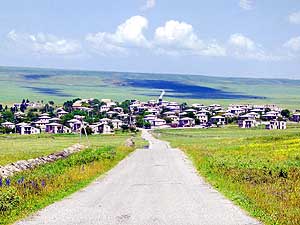
|
- 064
At Sagarejo, about 31 miles after
- Tbilisi on the M5 direction Azerbaijan, is the
- junction to the historic monastery site of
- "Davit Gareja". We drive for another 28 miles
- through a gorgeous untouched landscape .....
|
- 065
..... with green undulated hills
- and the salty Kopatidze lake
- (left picture #064) .....
|
- 066
..... and only interrupted by
- the single village of Udabno
|
-
- It is raining the next morning. We take breakfast in our room
and then drive to our embassy to collect our new passports. Our lady
consul, stationed in Tbilisi already since 3½ years, kindly invites
us inside to a cup of coffee. What was mostly the case in earlier
times became a rarity nowadays, the more we appreciate it. We learn
about a tourist who was in Armenia
and then traveled to Azerbaijan.
Apparently the Aseri confiscated everything which came from Armenia,
even postcards. If reciprocally Armenia would do the same arriving
with a stamp in the passport from Azerbaijan, she does not know.
Thus we have two options: Either we risk to cross into Azerbaijan
with our old already full passport or we are willing to take the
chances to run into problems at the Armenia border with an
Azerbaijan stamp in our new passport. Emil is opting for the first
version. Thus we leave our friendly embassy without our new
passports.
|
-
-
-
-

|
-
-

|
-
-
-
-

|
- 067
The otherwise lunar semi-desert
- landscape that leads to the remote
- "Davit Gareja" monastery site turns
- lush green early summer .....
|
- 068
..... and conjures up delicate
- bell flowers .....
|
- 069
..... and wonderfully colored
- natural flower carpets
|
-
- The following two days it rains incessantly. We therefore
postpone our city sightseeing until after our return from
Azerbaijan. On the third day, the sun is shining, the skies are blue
– it is a perfect day to travel. Fully motivated we roll on the M5
road towards the border of Azerbaijan.
After 31 miles [50km], the sign „Davit Gareja“ unexpectedly pops up.
It is the name of one of the most interesting historic sites of
Georgia containing around 15 scattered monasteries in complete
remoteness. We stop and puzzle over whether we should tackle the 28
miles [45km] still today and wether the road is passable at all. At
that very instant, we hear „Grüssgott“ (Greetings). A man hops out
of a green pickup. He is from Austria and winemaker and lives
already 20 years in Georgia. We ask him about the road condition.
„It should be OK“ he encourages us. Barely said, our decision is
made. We bunker another 13 gallons [50lt.] of gasoline and off we
go.
|
-
-

|
-
-
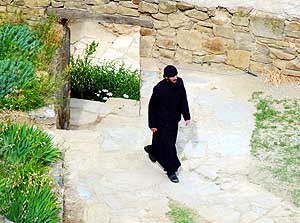
|
-
-

|
- 070
The Lavra Monastery of the
- "Davit Gareja" site was founded by
- Davit Gareja, a Syrian Father who returned
- in the 6th century to spread Christianity. A
- few caves are still inhabited by monks .....
|
- 071
..... one of the monks is returning
- from the monastery garden. Living in a
- very remote area, they are self-contained
|
- 072
The color of the “Davit Gareja” site
- coalesces with nature and spreads harmony
- and peace. Once there were 15 monasteries
- spread-out in this remoteness
|
-
- We are not prepared for the beauty that nature is pampering us
mile by mile. As far as our eyes can see we are surrounded by lush
green hills and a completely untouched landscape. We cross two
serene lakes and wonderful flowering fields, which make my heart
jump. Not a single house far and wide, only endless vastness and
pure nature. Looking at this dreamscape we even accept that the
paved road is getting worse with badly potholes and soon
deteriorates gradually into an almost 4x4 track. Reaching the „Davit
Gareja“ parking however, we are not alone. A noisy group of students
are just getting off their cars.
|
-
-

|
-
-

|
-
-

|
- 073
From the stony track that leads
- to the 2’880 ft. high hill ‘Udabno’, the
- Lavra monastery of "DavitGareja"
- presents itself in a new picture .....
|
- 074
..... Liliana makes a break
- from the strenuous climb in a shady
- corner of a rock cave .....
|
- 075
..... while Emil is enjoying the
- view from the boulders and poses
- for a picture
|
-
- What a beautiful place! We are carried away immediately by this
rock-hewn Georgian Orthodox Monastery complex with its cells carved
into the rock. It was founded by a Syrian father who returned from
the Middle East to spread Christianity in Georgia in the 6th
century. Surrounded by reddish rocks and delicate spring green the
restored and again inhabited Lavra Monastery spreads an incredible
harmony with nature – a pastel shade picture like in a storybook!
|
-
-

|
-
-

|
-
-

|
- 076
From the top of the hill above the
- "Davit Gareja" complex we are looking
- down to Azerbaijani territory .....
|
- 077
..... the Blue Rock-thrush
- (Monticola solitarius) choose also
- the highest spot .....
|
- 078
..... the ridge of hills dividing Georgia
- and Azerbaijan is rugged. In the far distance
- the Tsitskhituri tower is visible
|
-
- A stony strenuous path leads up a hill – on the other side is
Azerbaijan. Emil is already long
enjoying the views when I finally reach the top. „The 71 year old
even overtakes the students“ I am teasing him. Myself, I need to
take a rest once in a while. On the other hand I allow myself plenty
of time to marvel at the many partly unknown flowers and fluttering
butterflies in its diversity. The youngsters are slowly starting
their descent, then finally it gets quiet. Now also a bilious green
lizard comes out of hiding and two meters from where we are standing
a brown-red venemous viper disappears between two stones. It is just
of what travel guides specifically are warning against.
|
-
-

|
-
-

|
-
-

|
- 079
Lunchtime in pure nature at the
- "Davit Gareja" monastery site: Salami,
- bread, tomatoes, cucumbers, cheese
- and wine from Georgia
|
- 080
More beautiful than any flower
- bouquet made by hand – presumably
- a Great Masterwort (Astrantia major)
|
- 081
In the remoteness of "Davit Gareja"
- we even discover a Greek
- Tortoise/Spur-thighed Tortoise
- (Testudo graeca)
|
-
- As it often happens, also today we only find time for our
combined lunch/dinner meal at around 5pm: Salami, bread, tomatoes,
cucumbers, cheese and wine from Georgia. We set up our camping table
and chairs on a little earthen path at the edge of a yellow flower
field, where cattle are grazing. „Is it not beautiful here?“ I rave
enthusiastically until suddenly a jumbo of a bull seems to dislike
something about us, comes nearer and nearer and moos in a menacing
way. Also my dark blue windbraker which I hastily put over my red
T-shirt cannot chase it away, neither do Emil’s big stones.
|
-
-

|
-
-

|
-
-

|
- 082
During the short summer months,
- nature shows its best side – Small Heath
- (butterfly) (Coenonympha pamphilus)
|
- 083
Where is there a more beautiful
- night camp than here at the "end of the
- world"? There is not one light, not one
- noise – just the two of us and nature
- (at Davit Gareja)
|
- 084
Little things like a beautiful
- butterfly enlighten our days: Southern
- White Admiral (Limenitis reducta)
|
-
- I am really afraid that it attacks any moment. Emil laughs at
me. But a monk and two cattle herders who are in the vicinity seem
also to take it seriously; they also realise that something is
wrong. They come running and with a big stick chase the whole herd
away. Our peace is restored. Night approaches. There is not a single
noise and not one ray of light that disrupts our perfect idyll. Is
there a lovelier spot to spend the night than here at the end of the
world between all the splendor of flowers?
|
-
-

|
-
-

|
-
-
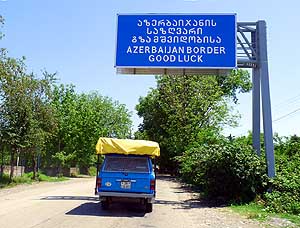
|
- 085
Rural life in Georgia is partly still
- like in the old days. It awakens nostalgia
|
- 086
Emil is not smiling for nothing.
- On his plate is one of his favorite
- dishes: "Khachapuri", a Georgian cheese
- pie. The beer stein also raises his spirit
|
- 087
On June 13th, 2013, our first leg
- in Georgia is finished after 570 miles. At
- Lagodekhi we drive towards the northern
- of the two Azerbaijan border crossings
|
-
- It is hard to break away from this peaceful corner. But today we
are crossing the border to Azerbaijan.
Back on the main road, we drive for many miles on a brutally
potholed road towards the border post where after 570 driven miles
[917km] our first part of the journey to
Georgia comes to an end. Our worries that due to our full passports
we could run into troubles at the Georgian border exit is invain.
The officer puts his exit stamp on the tiny empty corner next to the
entry stamp. Hopefully it will also work out that smoothly on our
second entry to Georgia in a couple of weeks with the same full
passports!
|
-
|
-
- The "Greater"-Middle East trip 2012/13:
- Sharjah/Dubai/1st Traveler's Festival/Emirates
National Auto Museum - UAE with
car Nov. 2012 to Jan. 2013 - part 1
- Western UAE - Liwa - United Arab Emirates with car in January 2013 - part 2
- Oman 2013 - Part 1 - February
2013: Musandam Peninsula
- Oman 2013 - Part 2 - February
2013: Sohar - Muscat - Rustaq - Nizwa
- Oman 2013 - Part 3 - March
2013: Sur - East Coast - Island of Masirah - Dhofar
- Oman 2013 - Part 4 - March
2013: Salalah & Surroundings (Dhofar) - Nizwa
- Oman 2013 - Part 5 - March 2013: Western Hajar
Mountains
- Al Ain, Eastcoast & Ras al Khaima - United
Arab Emirates with our car in April 2013 -
part 3
- Iran -
Part 1: Ferry Port Bandar Abbas-Shiraz-Persepolis-Pasargad (between Persepolis and Yazd)
– May 2013
- Iran -
Part 2: Pasargad
(excl.)-Yazd-Esfahan – May 2013
- Iran -
Part 3: Esfahan
(excl.)-Chelgerd-Hamadan-Sanandaj-Orumiyeh-Turkey Border
– May 2013
- Turkey - Iran Border-Esendere-Hakkari-Van-Doğubayazıt-Kars-Ardahan-Hopa-Georgia
Border – May/June 2013
- Azerbaijan: Georgia Border-Balakən-Şəki-Lahıç-Baku-Xınalıq-Quba-Laza-Baku-Gəncə-Georgia Border – June 2013
-
Georgia - Part 2a: Azerbaijan Border-Tbilisi-Armenia
Border –
June/July 2013
- Armenia - Part 1: Georgia Border-Haghpat-Dilijan-Sevan-Tatev-Goris-Nagorno Karabakh – July 2013
- Nagorno-Karabakh:
Armenia-Stepanakert-Gandzasar-Martakert-Tigranakert-Tnjri-Shoushi-Armenia – July
- Armenia -
Part 2:
Nagorno Karabakh-Goris-Tatev-Noravank-Khor Virap-Echmiadzin-Yerewan-Geghard-Gyumri-Georgia Border – July 2013
- Georgia -
Part 2b: Armenia Border-Ninotsminda-Tbilisi-Mtskheta-Kazbegi-Kutaisi-Zugdidi –
July 2013
- Georgia -
Part 3a:
Zugdidi-Swaneti-Zugdidi-Abkhazia Border – July/August 2013
- Abkhazia: Georgia-Sukhumi-Tsebelda-Novyy Aton-Lake
Ritsa-Gagra-Pitsunda-Georgia – August
2013
- Georgia - Part 3b: Abkhazia Border-Poti-Ferry to Ilyichevsk/Ukraine
– August 2013
|
|
![]()



